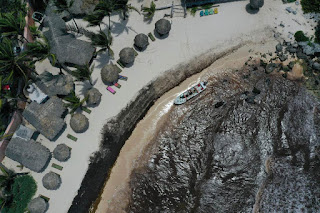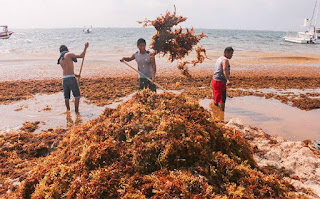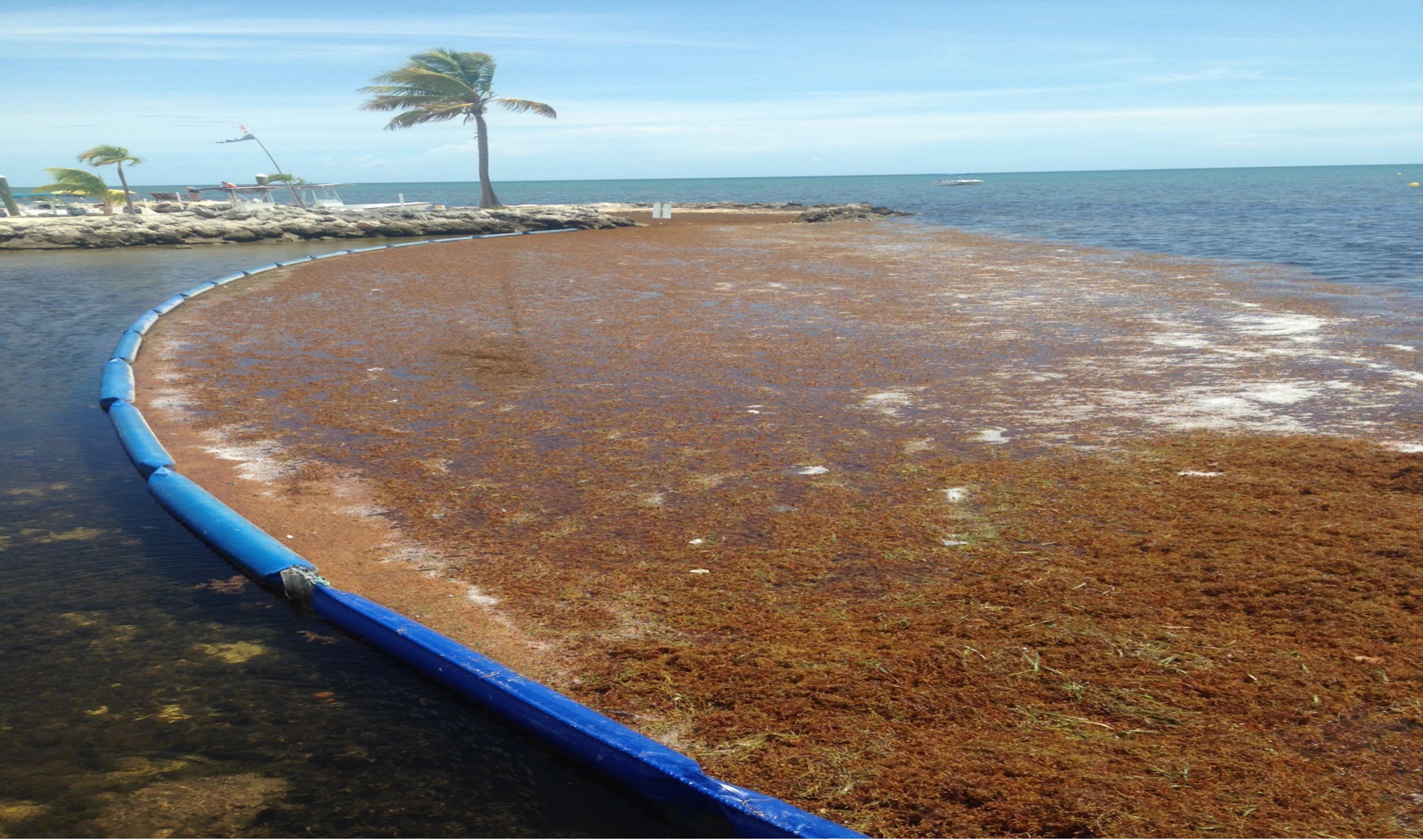Masses of sargassum are washing up on Caribbean beaches, hurting tourism, ravaging ecosystems, and overwhelming beaches. In Cancún, previously pristine beaches are covered in the large brown seaweed that usually floats in the ocean.
So, what can be done?
The first step in controlling sargassum is to understand where it is coming from, why the bloom is so large, and how to prevent it from coming ashore to rot.
Predicting Sargassum Blooms

As sargassum blooms and creeps toward shorelines, it’s only natural to wonder how much will be coming in the next few months.
The University of South Florida Optical Oceanography Lab’s Satellite-based Sargassum Watch System (SaWS) offers insight into how much, where, and when the sargassum is coming. This program uses satellite data and numerical models to detect and track sargassum as it moves.
SaWS recently released its sargassum outlookbulletin for June and some information about the coming months. The bulletin confirmed the high amount of sargassum beaching in the Caribbean, as well as large amounts in the central west Atlantic Ocean and the eastern Gulf of Mexico.
While the estimated sargassum this year is less than was recorded in 2018, which saw more than 20 million metric tons, the total estimated amount this year is supposed to be greater than 10 million metric tons, which is greater than 2015’s sargassum conditions.
Sargassum Watch System at a Glance:
- Large amounts of sargassum are predicted for July and August in the Caribbean Sea and Gulf of Mexico.
- This year’s sargassum bloom is the second highest recorded year for the same month.
- Total estimated amount of sargassum is greater than 10 million metric tons so far this year.
The exact amount of sargassum present on beaches will be determined by ocean tides, circulations, and winds. As mentioned above, the sargassum watch system is an estimation, not a direct prediction.
Caribbean Beaches Struggling with Sargassum
Recently, Mexico enlisted its Navy to remove the sargassum from some of its beaches and water using heavy machinery. The government hoped this would be cost-efficient, but despite its best efforts the problem may have only gotten worse.
Because of this intense sargassum build-up in the Caribbean, representatives from several countries gathered on June 27 in Cancúnto discuss strategies to combat sargassum on Caribbean beaches.

Some of the Caribbean countries in attendance:
- Mexico
- Honduras
- Nicaragua
- The Dominican Republic
- Jamaica
- Trinidad and Tobago
Officials met not to solve the sargassum problem outright, but to collaborate between each other to better coordinate solutions. Some of those solutions included supporting extra research into the sargassum bloom and developing a warning system similar to ones we have for other natural phenomena.

Typical, But Ineffective, Methods of Sargassum Control
A typical method of sargassum control is to remove it directly from the beaches, but this has its problems. Simply removing the sargassum from the Caribbean shorelines, either by hand or with costly equipment that needs to be maintained, is a tedious, short-term task, rather than a long-term solution.
When you remove it from the beach, you must have a designated area, away from the public, where you can dispose of it due to its corrosive, toxic nature when it decomposes.
Rotting sargassum problems:
- Emits toxic, corrosive gas
- Attracts invasive insects
- Destabilizes beaches, causing erosion
Unlike other sargassum clean-up methods, a floating containment boom can last awhile and doesn’t require multiple clean-up attempts. This solution meets the sargassum where it exists—in the water.
A Good Solution:Stop Sargassum from Coming Onshore
An effective solution for sargassum control is to stop it while it is still mobile and floating in the water.
Sargassum floats because its berry-like pneumatocysts are filled with air and provide buoyancy on the surface of the water in rafts. Floating rafts of sargassum provide needed habitats for fish, turtles, crabs, and birds.
Sargassum itself is not bad, but problems arise when it grows at an exponential rate as a result of nutrient-rich waters from fertilizer runoff and pollution. If the sargassum is creeping onshore in exponential amounts before it can sink, containing it away from shore is the best solution.
Cost effective solutions to controlling sargassum include using a floating containment boom, also called a floating barrier. These floating barriers contain:
- Trash
- Debris
- Seaweed
Using a permanent barrier, that won’t allow sargassum to wash over it and requires minimal attention, will keep more sargassum away from the shore for a longer period of time. A permanent barrier is a great solutionfor resorts and hotels, who want to keep their beachfronts clean for guests and swimmers.
Keeping the beaches clean is essential for hotels and businesses around Quintana Roo and Playa del Carmen to survive. For Cancún, Playa del Carmen, Puerto Morelos, Tulum, Cozumel, and Isla Mujeres, tourism is at stake with the invasion of sargassum.
Floating Seaweed Barrier
The benefits of a floating seaweed barrier are abundant. For one, they keep sargassum away from beach goers. Once installed, floating barriers need inspections twice a week or after intense weather.
As sargassum is contained in the barrier, the beach stays clean, and the need for widespread cleanup is eliminated.
Working to remove sargassum from pristine beaches, and ensuring that it doesn’t come back, requires the right tools. The Orion Aquatic Plantand Containment Boom from GEI Works deflects and diverts sargassum from shorelines all while effectively containing it.
Inspect your sargassum containment boom to make sure that is performing at its highest level. Twice a week, check the boom, connections, lines, and buoys for functionality. Also, remove any build-up of sargassum that could threaten the boom.
The best practices for keeping and maintaininga sargassum containment boom can be simple.

Contact GEI Works to receive help and to discuss your sargassum issues at +1-772-646-0597.
Posted by GEI Works No comments:
Email ThisBlogThis!Share to XShare to FacebookShare to Pinterest
Labels: beach cleanup, beach pollution, Caribbean, containment boom, Mexico, sargassum, seaweed & aquatic plant control, tourism, water pollution
The Massive Sargassum Seaweed Bloom of 2018: What It Means and What To Do
Sargassum has been washing ashore on Caribbean beaches at record levels this year–nearly 3x the last record set in 2015.
Sargassum seaweed is an important ecosystem in the Atlantic Ocean, but it can be devastating to Caribbean beaches. Many beach resorts are suffering from an unprecedented invasion of sargassum, causing some to close their doors during the current summer season. Many of the communities now being affected by seaweed are still recovering from Hurricane Irma, so bringing back tourism dollars is especially critical.
So what can be done to help? There are several innovative possibilities, but before providing sargassum solutions, it’s important to understand more about sargassum.
The Good and the Bad of Sargassum
In the Sargasso Sea, an area in the Atlantic Ocean covering 2 million square miles, massive floating rafts of Sargassum provide food and shelter for many species of fish, shrimp, turtle, and crabs—some of them endangered species. In moderate amounts, Sargassum washes up on beaches, providing a source of food for wildlife, and helping protect the beach from wind and water erosion.
However, excessive amounts of Sargassum can starve the coastal waters of oxygen, causing mass fish death, and preventing endangered sea turtles from nesting. Natural vegetation that lives on the ocean floor can also die off—the murky seaweed blocking the natural light plants need to thrive.
Efforts to remove the seaweed may risk destabilizing beaches causing erosion and crushing sea turtle nests. Therefore, most cleanup efforts require extra caution and intense manual labor and painstaking raking. As the seaweed washes onshore, it piles up and decays, which attracts invasive insects. It also releases a toxic gas called hydrogen sulfide. Many cleanup crews have experienced hydrogen sulfide poisoning from exposure to large amounts of decaying Sargassum with flu-like symptoms: nausea, headaches, and eye and skin irritation.
Hydrogen sulfide is also particularly corrosive, leading to rapid damage to A/C equipment, electrical systems, and plumbing in nearby areas. Schools, hotels and resorts, restaurants, and even sailing clubs have been seeing the effects of Sargassum reaching into their pockets. The invasive seaweed causes closures, lost tourism dollars, and requires ongoing cleanup throughout the summer months when Sargassum is flourishing.
What causes these massive seaweed blooms? Leading researcher Brian LaPointe of Florida Atlantic University states that “our research has found that nitrogen and phosphorus from land-based runoff and pollutants, including nitrogen-heavy fertilizers and sewage waste, are washing into rivers such as the Mississippi and the Amazon. This fuels sargassum growth.”
And grow it does. In 2015, the last record Sargassum bloom affected large swaths of the Caribbean and Gulf of Mexico, and even caused Mexico to deploy its military to deal with the issue.
Sargassum’s Record Breaking Influx and Impact to the Caribbean
The University of South Florida’s Optical Oceanography Lab analyzes satellite imagery to predict troublesome Sargassum blooms.
In January, 2018, researchers detected an abnormal amount of Sargassum in the Caribbean and Western Atlantic, predicting that 2018 would be a major year for Sargassum blooms. They were correct. In the chart, it is shown that as of June 2018, the Sargassum levels are nearly 3x the record breaking high of 2015.
The natural ocean currents help to predict where the sargassum will travel.
Those currents have driven the sargassum right into the Caribbean, and along the Central American eastern coastline.
The effects on the environment and tourism industry this year have already been devastating. The Organization of Eastern Caribbean States met recently to discuss the impact of Sargassum in the Windward Islands. Barbados’ National Conservation Commission has called their fight against Sargassum “a valiant battle,” as the seaweed inundates its northern, eastern, and southern coastlines. Jamaica’s government has allocated $5 million for the removal of Sargassum from its beaches. South Florida has also seen mass deposits of Sargassum, especially in Miami and Ft. Lauderdale.
On Martinique, incredible amounts of Sargassum have been choking local waterways. The French government is planning an intervention, allocating £3.5 million to supply some of its islands in the Caribbean with tractors, gas masks, and other equipment. On Martinique especially, piles of Sargassum have been responsible for mass fish death and even a school closure. On Grand Cayman, the Department of Environment asks to be consulted before any cleanup attempt, and have forbidden the use of heavy machinery without written consent. In Cayman Brac, sea turtle hatchlings were found entangled in masses of Sargassum, unable to reach the shore.
Unique Problems Call for Unique Solutions
GEI Works not only manufactures unique product solutions for environmental issues, we are continually learning about new methods and procedures for mitigating disasters like the Sargassum Bloom of 2018.
Clean beaches matter. In 2015, when the last record bloom struck the Caribbean, we sent a team to the Dominican Republic to learn more about the invasive seaweed while our production team worked overtime to construct a solution that could be immediately deployed. When sargassum is overwhelming your beach, immediate action is needed. GEI Works can quickly mobilize to get the fast answers that are needed.
We have worked with many beach resorts and communities in a variety of coastal locations. We help them with their emergency sargassum problems, providing the fast response they need to get the sargassum under control. The areas we have provided solutions to include:
- Antigua
- Turks & Caicos
- British Virgin Islands
- Grand Cayman
- Dominican Republic
- Belize
- Florida Keys
- New York
- Dania Beach
- And Many Others in the U.S. and the Caribbean
For Sargassum control, we usually recommend a sargassum containment boom or a permanent boom for longer-term containment. The booms work in calm or moving water, varying tidal conditions, and are built to withstand UV-exposure and extreme temperatures. Anchoring the entire structure is essential. Protect your investment with our full line of accessories for the booms, including anchoring kits. These help stabilize and support the boom and maximize effectiveness.
The Orion Aquatic Plant and Containment Boom helps contain Sargassum blooms in three different ways.
- Deflection: use the Aquatic Plant Boom to keep Sargassum off the beach. This is particularly useful in coves or protected beaches. The containment boom floats on the surface of the water, allowing fish, sea turtles, and other marine life to pass underneath it.
- Diversion: use the Aquatic Plant Boom to deflect Sargassum from hotel and resort beaches to nearby beaches where it can be collected. Reduces the impact on the tourism industry.
- Containment: Use the containment boom to collect Sargassum in open water where it can be collected.
Your project’s budget, specifications, requirements, and environmental conditions factor into the specific sargassum solution that’s right for you. That’s why we work with each client individually and consult global experts to help find the right solution for your needs. If you’re experiencing issues with Sargassum, we are interested in hearing from you. Rather than simply suggesting a product, we seek the right solutions!
Contact GEI Works to receive help and to discuss your Sargassum issues at +1-772-646-0597.




